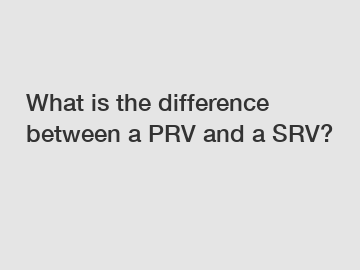What is the difference between a PRV and a SRV?
Pressure relief valves (PRVs) and safety relief valves (SRVs) are crucial components in various industrial processes that involve the transportation and containment of fluids under pressure. While these valves serve similar purposes, there are key differences between PRVs and SRVs that make them distinct from each other. Understanding these differences is essential for ensuring the proper selection and installation of these valves in industrial applications.
**Function and Purpose**.
Pressure relief valves (PRVs) are designed to protect systems from overpressure conditions by relieving excess pressure in a controlled manner. PRVs are typically set to open at a specific pressure level, allowing the pressure to be reduced to a safe level before closing again. This helps prevent equipment damage and potential safety hazards caused by excessive pressure buildup in the system.

On the other hand, safety relief valves (SRVs) are specifically designed to provide protection against overpressure situations that could result in catastrophic failures or explosions. SRVs are set to open rapidly when the pressure exceeds a predetermined threshold, releasing the excess pressure quickly to prevent any potential harm or damage to the system or surrounding environment. SRVs are considered the last line of defense in ensuring safety in high-pressure systems.
**Design and Construction**.
PRVs and SRVs are constructed differently to accommodate their respective functions. PRVs are often designed with adjustable settings that allow for precise control over the pressure at which the valve will open. This adjustability makes PRVs versatile and suitable for various applications where pressure relief is necessary but not critical for safety.
In contrast, SRVs are built with a more robust and reliable design to withstand extreme pressure conditions and ensure rapid and decisive relief when required. SRVs are typically designed with a higher flow capacity than PRVs to handle the sudden release of pressure in emergency situations effectively. The construction of SRVs prioritizes safety and reliability over adjustability and versatility.
**Regulatory Requirements**.
Both PRVs and SRVs are subject to various regulatory standards and requirements to ensure their proper functionality and performance in industrial applications. PRVs are commonly used in systems where pressure relief is necessary but does not pose an immediate safety risk. As such, PRVs are often regulated by industry standards that dictate their design, installation, and maintenance practices.
On the other hand, SRVs are subject to more stringent regulations and standards due to their critical role in protecting against catastrophic failures. SRVs must meet specific certification requirements and undergo regular testing to verify their performance under extreme conditions. Regulatory compliance for SRVs is essential to ensure the safety and integrity of high-pressure systems where these valves are installed.
**Conclusion**.
In conclusion, the key difference between a PRV and an SRV lies in their intended function, design, and regulatory requirements. PRVs are primarily used for controlled pressure relief in systems where safety risks are minimal, while SRVs are specifically designed for rapid and decisive relief in emergency situations to prevent catastrophic failures. Understanding these differences is crucial for selecting the appropriate valve for a given application and ensuring compliance with industry standards.
For more information about PRVs and SRVs or assistance in selecting the right valve for your industrial application, please do not hesitate to contact us. We are here to help you with all your pressure relief valve needs.
The company is the world’s best peek o rings, surface safety valve wellhead, peek o ring supplier. We are your one-stop shop for all needs. Our staff are highly-specialized and will help you find the product you need.

Comments